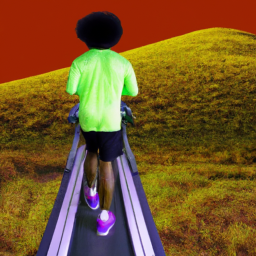Have you ever experienced being in a dream where you’re attempting to run, but your legs simply won’t listen? It can be a frustrating and scary situation, leaving you feeling vulnerable and helpless. I have personally faced this issue and have often wondered why I can’t run in my dreams.
As it turns out, there is a scientific explanation for why we can’t always move our bodies as we want to in our dreams. During the rapid eye movement (REM) stage of sleep, our bodies become physically paralyzed to prevent us from acting out our dreams in real life. This paralysis is known as atonia and is necessary for our safety and the safety of those around us.
However, this atonia can also affect our dream experiences, causing us to feel as though we are unable to move or run in our dreams.
Key Takeaways
- Muscle atonia during REM sleep is necessary for safety, but it also causes physical paralysis and the inability to move in dreams.
- Lucid dreaming is becoming aware that you are dreaming and can control your dream, which can be achieved through practicing techniques such as reality checking and visualization.
- Common dream experiences such as falling, being chased, and teeth falling out can provide insight into the subconscious mind.
- Practicing mindfulness and meditation, as well as keeping a dream journal to identify patterns and themes, can increase the chances of experiencing lucid dreaming.
The Science Behind Dreaming
Dreaming is a complex process that involves multiple regions of the brain working together, which is why we can’t always control our dreams.
When we fall asleep, our brains go through different stages of sleep, one of which is known as REM sleep. During this stage, our brain becomes very active, and we have the most vivid dreams.
However, despite the increased activity in our brains during REM sleep, our bodies are actually physically paralyzed. This is a protective mechanism to prevent us from acting out our dreams and potentially harming ourselves or others.
It’s this physical paralysis during REM sleep that prevents us from being able to run or move freely in our dreams.
Physical Paralysis During REM Sleep
During REM sleep, my body experiences muscle atonia, which prevents movement and helps keep me from acting out my dreams. This means that even though I may be running in my dream, my body remains still and immobile.
This physical paralysis is a natural process that occurs during REM sleep, and it’s essential for the body’s rest and rejuvenation. Some people may experience sleep paralysis, a condition where the muscle atonia continues even after waking up, leading to a temporary inability to move or speak.
However, for most people, the muscle atonia only lasts during the REM phase of sleep. So, while I may not be able to physically run in my dreams, the sensation of running can still feel very real and vivid.
The Sensation of Running in Dreams
The exhilaration of sprinting through endless fields is a feeling that can be experienced in the depths of slumber. However, despite the vividness of dreams, the sensation of running is often elusive. Here are some possible reasons why:
-
Lack of Control: Dreams are often unpredictable, and our subconscious mind may not allow us to fully control our movements, making it difficult to run with intention.
-
Perception of Time: Time can be warped in dreams, making it difficult to gauge distance and speed accurately. This can make running feel like a slow, sluggish movement or an endless, futile chase.
-
Physical Limitations: Our physical body is not engaged in the dream world, and our muscles are relaxed during REM sleep. Therefore, the physical sensation of running may not be accurately reproduced in our dreams.
-
Mental Barriers: Fear, anxiety, or stress can manifest as obstacles in our dreams, even if they’re not present in reality. These mental barriers can inhibit our ability to run freely and confidently in our dreams.
-
Dream Themes: Dreams often have recurring themes or symbols, and running may not be a part of these recurring themes, making it less likely to occur in our dreams.
Despite the challenges of running in our dreams, there are still other common dream experiences that we can enjoy.
Other Common Dream Experiences
Have you ever woken up from a dream feeling like you were flying? That’s a common dream experience known as lucid dreaming. Lucid dreaming is when you become aware that you are dreaming and can control your dream. It’s a fascinating experience that allows you to explore the depths of your subconscious mind and do things that are impossible in real life.
Lucid dreaming is not the only common dream experience. There are several other dream experiences that people commonly report. To help you understand them better, here’s a table that lists some of the most common dream experiences and what they could mean:
| Dream Experience | Possible Meaning |
|---|---|
| Falling | Fear of losing control |
| Being chased | Fear of a problem or situation |
| Teeth falling out | Anxiety or fear of losing power |
| Naked in public | Fear of embarrassment or exposure |
| Flying | Feelings of freedom or power |
Understanding your dream experiences can help you gain insight into your subconscious mind and identify areas of your life that may need attention. Now, let’s move on to some tips for controlling your dreams.
Tips for Controlling Your Dreams
When it comes to controlling your dreams, there are a few techniques that have worked for me.
First, I’ve found that practicing lucid dreaming techniques helps me become aware that I’m dreaming and allows me to take control of the dream.
Another helpful tool is keeping a dream journal. This allows me to remember my dreams more vividly and identify recurring themes.
Lastly, practicing mindfulness and meditation before bed can help me enter a relaxed state and increase the likelihood of having a lucid dream.
Lucid Dreaming Techniques
You can actually control your dreams through lucid dreaming techniques, allowing you to run and move freely in your dream world.
One technique is reality checking, which involves questioning whether you’re dreaming or not throughout the day. This helps you recognize when you’re in a dream and can take control of it.
Another technique is visualization, where you imagine what you want to happen in your dream before falling asleep. This can help you manifest that scenario in your dream and take control of it as well.
Lucid dreaming can be a powerful tool for experiencing things you may not be able to in waking life, such as flying or running at superhuman speeds. However, it takes practice and dedication to master these techniques.
One way to improve your lucid dreaming skills is by keeping a dream journal, where you write down your dreams as soon as you wake up. This helps you remember your dreams more vividly and can give you insight into recurring themes or situations in your dreams.
By consistently practicing lucid dreaming techniques and keeping a dream journal, you can unlock the full potential of your dream world.
Keeping a Dream Journal
By regularly recording your dreams in a journal, it becomes easier to identify common patterns and themes that may provide insight into your subconscious mind. This practice can also help you remember your dreams more vividly, making it easier to recognize when you’re dreaming.
Additionally, keeping a dream journal can help you become more aware of your thoughts and emotions, both during your waking hours and in your dreams. By becoming more aware, you can begin to practice mindfulness and meditation, which can help you achieve lucid dreaming.
By staying present in the moment and focusing on your breath, you can train your mind to recognize when you’re dreaming and take control of your dreams. So, start keeping a dream journal today and begin your journey towards lucid dreaming and greater self-awareness.
Practicing Mindfulness and Meditation
Practice mindfulness and meditation to take control of your mind and achieve lucid dreaming. It’s important to stay present and aware of your surroundings in both waking life and dreams. Here are three ways to incorporate mindfulness and meditation into your daily routine to increase your chances of lucid dreaming:
-
Start your day with a few minutes of meditation. Sit quietly and focus on your breath, clearing your mind of any distractions. This will help you develop a stronger sense of awareness and control over your thoughts.
-
Throughout the day, practice mindfulness by paying attention to your surroundings. Notice the sights, sounds, and smells around you. This will help you stay present and aware in your waking life, which can carry over into your dreams.
-
Before going to bed, take a few minutes to visualize yourself becoming aware in your dreams. Imagine yourself realizing that you are dreaming and taking control of the dream. This can help set the intention for lucid dreaming and increase the likelihood of it happening.
By incorporating mindfulness and meditation into your daily routine, you can increase your chances of having lucid dreams and taking control of your dream world. Remember to stay present and aware, both in your waking life and in your dream world.
Frequently Asked Questions
What is the meaning behind running in dreams?
Running in dreams can symbolize a sense of urgency or the need to escape a situation. It can also represent a desire for freedom or control. However, the meaning can vary depending on the individual’s personal experiences and emotions.
Can everyone control their dreams?
I have had lucid dreams where I was able to control my actions, but not everyone can. It takes practice and training to achieve lucid dreaming, and even then it may not be perfect.
Why do some people have nightmares more often than others?
I have noticed that my stress levels, medication and sleep patterns can affect my frequency of nightmares. Some individuals may have more intense dreams due to trauma or anxiety disorders.
Is there a way to prevent physical paralysis during REM sleep?
By sheer coincidence, I stumbled upon a technique called lucid dreaming that allowed me to overcome physical paralysis during REM sleep. With practice, I learned to control my dreams and even run in them.
Can you learn to lucid dream and run in your dreams on command?
Yes, I learned to lucid dream and run in my dreams on command. It took practice and awareness of being in a dream state. Once I realized I was dreaming, I could control my actions.
Conclusion
As I lay in bed, I couldn’t help but wonder why I always feel like I’m trying to run in slow motion in my dreams.
After doing some research, I learned about the science behind dreaming and how our bodies become physically paralyzed during REM sleep. It made sense why I couldn’t move as fast as I wanted to in my dreams.
But despite the physical limitations, I also discovered that there are ways to control and manipulate our dreams. And with a little practice and patience, I can finally experience the sensation of running freely in my dream world.
It’s like unlocking a new level in a video game, and I can’t wait to see where my dreams will take me next.










